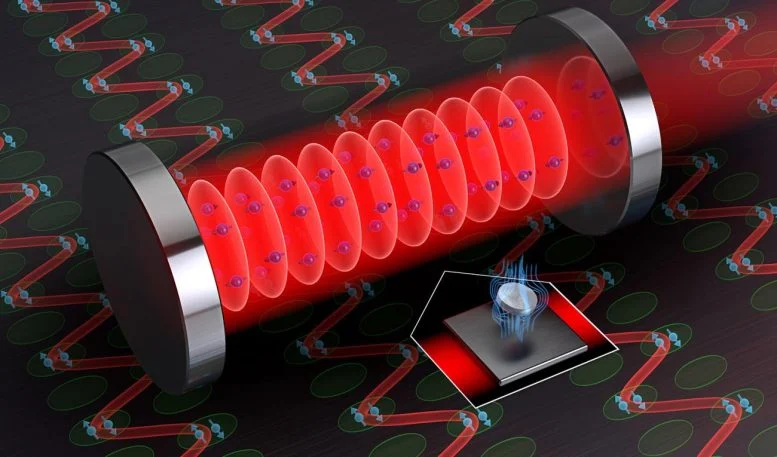Superconductivity makes physics look like magic. At low temperatures, superconducting materials allow electricity to flow indefinitely, throwing off external magnetic fields and causing them to levitate above the magnets. MRIs, magnetic trains, and high-energy particle accelerators use superconductivity, which also plays an important role in quantum computing, quantum sensors, and quantum measurement science. One day, superconducting power grids will be able to deliver electricity with unprecedented efficiency.
Problems with superconductors
But scientists don’t have full control over traditional superconductors. These solid materials often contain more than one type of atoms in complex structures that are difficult to manipulate in the laboratory. It is even more difficult to study what happens when there is a sudden change, such as a jump in temperature or pressure, that throws the superconductor out of balance.
Quantum theory has predicted intriguing behavior when a superconductor goes out of equilibrium. But it has been difficult to disrupt these materials in the laboratory without disrupting their delicate superconducting properties, leaving these predictions untested.
JILA Innovative Research
But scientists can gain a surprisingly deep understanding of superconductivity by studying it with completely controlled arrays of atoms in a gas. This is a collaborative research approach at JILA, a joint institute of the National Institute of Standards and Technology (NIST) and the University of Colorado Boulder.
In their latest work, JILA researchers enabled a gas composed of strontium atoms to act as a superconductor. Although strontium atoms are not superconductors, they obey the same rules of quantum physics. The researchers can make the atoms in the gas interact in a way that preserves the types of interactions responsible for superconductivity and suppresses other competing, complex interactions. By putting the atoms out of balance, the researchers saw changes in how the atoms interacted, which could affect the properties of real superconductors.
With strontium gas acting as a “quantum simulator,” researchers were able to observe superconducting behavior that had been predicted for years. This study published Nature , It offers new insights into how superconductors work when properly removed from equilibrium, and sheds light on how superconductors can be made more reliable and how their unique properties can be exploited in other quantum technologies.
“How powerful are these things?”
In a normal material, electrons move in an uncoordinated manner and constantly bump into each other; Electrons generally repel each other. As they move, they collide, lose energy and produce heat; This is why electric currents dissipate when electrons flow in a metal wire. However, in a superconductor, electrons are combined into weakly bonded pairs called Cooper pairs. When these vapors form, they all tend to move together and thus flow through the material without resistance.
In one sense, physics is simple, explains theoretical physicist Ana Maria Rey of NIST and JILA. Cooper pairs exist in a low-energy state because fluctuations in the material’s crystal structure bring electrons together. The formed Cooper pairs prefer to act together and unite. Cooper pairs are like “arrows” that want to line up in the same direction. Ray explains that to unlock them, or to make one of the arrows point in a different direction, you need to add extra energy to break the Cooper pairs apart. The energy that must be added to unlock them is called the energy deficit. A stronger interaction between atoms creates a larger energy gap because the attraction holding Cooper pairs is so strong. Bridging this energy gap takes a lot of energy from Cooper’s steam. Therefore, this energy gap acts as a buffer, ensuring that the Cooper pairs remain happily locked in phase.
All of this works when the system is in balance. But when you initiate a sudden and rapid change, the superconductor goes out of balance or is “quenched.” For decades, scientists have wanted to know what would happen to superconductivity, JILA physicist James Thompson said, saying it was sudden but not strong enough to completely break the Cooper pairs.
“In other words, how powerful are these things?” said Thompson.
Theorists have predicted three different possibilities, or phases, that might occur when a superconductor quenches. Think of it as a large group of dancers, Thompson says. At first, everyone synchronizes to the beat of the music. Then some people get a little tired or some people start moving too fast and they crash into each other and it turns into a ditch. This is Phase I, where superconductivity breaks down. In Phase II, dancers lose time but manage to stay in harmony. Superconductivity survives quenching. Scientists were able to observe and study these two stages.
But they never saw the long-predicted third phase, in which the superconductivity of the system fluctuates over time. At this stage our dancers will move a little faster or a little slower, but no one will crash. This means that sometimes it is a weaker superconductor and sometimes it is a stronger superconductor. So far, no one has been able to observe this third stage.
“Everything flows”
Working with Ray’s theoretical group, Thompson’s team at JILA cooled a laser and loaded strontium atoms into an optical cavity with highly reflective mirrors at each end. Laser light bounces back and forth millions of times before some light escapes from one end.
Ray explains that light in the vacuum mediates interactions between atoms, causing them to enter a superposition state (that is, they are both excited and ground state at the same time) and phase locking.
Using lasers, scientists can quench the system and measure the light that escapes to learn how the energy gap changes over time. With this simulation of a quantum superconductor, they were able to observe all three dynamical phases for the first time.
In the third step, they found that the energy gap can maintain superconductivity even when the system is not in equilibrium. Using such quantum simulators could help scientists develop unconventional or more reliable superconductors and better understand superconductor physics in general.
This is also a controversial way for measurement scientists to view energy-deficit-causing atomic interactions as a blessing rather than a bane.
“In measurement science, interactions are often bad. But here they can help you when interactions are strong. The rail protects the gap system; “Everything flows,” he says. “There may be something at the core of this idea that oscillates forever.”
Thompson adds that having something that oscillates indefinitely is a dream for quantum technology because it would allow sensors to perform better for longer periods of time. Like superconductors, groups of atoms, photons, and electrons in quantum sensors must remain synchronized or coherent to work, and we don’t want them to become a quantum sink or “dephase.”
“I’m excited that one of the dynamical phases we observed could be used to protect quantum optical coherence from phase loss. For example, it could one day allow optical atomic clocks to run longer,” Thompson said. “This is a completely new way to improve the accuracy and sensitivity of quantum sensors, a topic at the forefront of quantum metrology, or measurement science. We want to use large numbers of atoms and exploit interactions to create a better sensor.”













